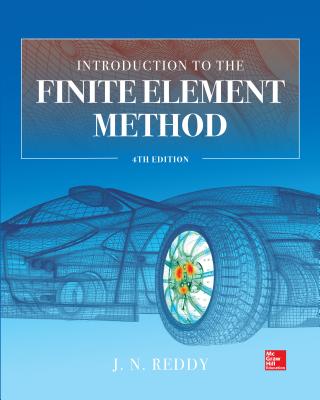Introduction to Structural Analysis: Displacement and Force Methods (Hardcover)
暫譯: 結構分析導論:位移與力法 (精裝版)
S. T. Mau
- 出版商: CRC
- 出版日期: 2012-04-26
- 售價: $1,200
- 貴賓價: 9.8 折 $1,176
- 語言: 英文
- 頁數: 328
- 裝訂: Hardcover
- ISBN: 1466504161
- ISBN-13: 9781466504165
下單後立即進貨 (約5~7天)
買這商品的人也買了...
-
 C++ Builder 與影像處理, 2/e
C++ Builder 與影像處理, 2/e$320$304 -
 王者歸來-用 Linux 移植各種硬體
王者歸來-用 Linux 移植各種硬體$620$527 -
 Multidimensional Signal, Image, and Video Processing and Coding, 2/e (Hardcover)
Multidimensional Signal, Image, and Video Processing and Coding, 2/e (Hardcover)$1,380$1,352 -
 Practical Image and Video Processing Using MATLAB (Hardcover)
Practical Image and Video Processing Using MATLAB (Hardcover)$6,540$6,213 -
 Permanent Magnet Brushless DC Motor Drives and Controls (Hardcover)
Permanent Magnet Brushless DC Motor Drives and Controls (Hardcover)$8,380$7,961 -
 Microprogrammed State Machine Design (Hardcover)
Microprogrammed State Machine Design (Hardcover)$8,100$7,695 -
 跟著範例學會 Visual C# 2015 (適用2015/2013)
跟著範例學會 Visual C# 2015 (適用2015/2013)$420$328 -
 物聯網實作:工業4.0基礎篇, 2/e (附光碟)
物聯網實作:工業4.0基礎篇, 2/e (附光碟)$520$468 -
 7天學會 Android App 程式開發
7天學會 Android App 程式開發$450$351 -
 $280機器學習入門到實戰 — MATLAB 實踐應用
$280機器學習入門到實戰 — MATLAB 實踐應用 -
 Excel VBA 實戰技巧|金融數據 x 網路爬蟲
Excel VBA 實戰技巧|金融數據 x 網路爬蟲$620$490 -
 最新圖解馬達入門
最新圖解馬達入門$300$255 -
 超圖解 Arduino 互動設計入門, 4/e
超圖解 Arduino 互動設計入門, 4/e$680$537 -
 工業4.0 的物聯網智慧工廠應用與實作:使用 Arduino.Node-RED.MySQL.Node.js
工業4.0 的物聯網智慧工廠應用與實作:使用 Arduino.Node-RED.MySQL.Node.js$500$390 -
 FPGA 數字圖像採集與處理 — 從理論知識、模擬驗證到板級調試的實例精講
FPGA 數字圖像採集與處理 — 從理論知識、模擬驗證到板級調試的實例精講$414$393 -
 $352無線秘籍 — 射頻電路設計入門
$352無線秘籍 — 射頻電路設計入門 -
 OpenCV 4.5 電腦視覺開發實戰 (基於 VC++)
OpenCV 4.5 電腦視覺開發實戰 (基於 VC++)$534$507 -
 機器學習與振動信號處理
機器學習與振動信號處理$354$336 -
 極深入卻極清楚:電腦網路原理從 OSI 實體層到應用層
極深入卻極清楚:電腦網路原理從 OSI 實體層到應用層$880$695 -
 $560數字圖像處理與機器視覺 — Visual C++ 與 Matlab 實現, 2/e
$560數字圖像處理與機器視覺 — Visual C++ 與 Matlab 實現, 2/e -
 C語言學習指南:從規範編程到專業級開發
C語言學習指南:從規範編程到專業級開發$894$849 -
 乙級檢定學術科完全攻略-電腦輔助機械設計製圖 (2022最新版)(附參考解答、學科測驗卷)
乙級檢定學術科完全攻略-電腦輔助機械設計製圖 (2022最新版)(附參考解答、學科測驗卷)$660$594 -
 ANSYS Workbench中文版超級學習手冊
ANSYS Workbench中文版超級學習手冊$599$569 -
 超圖解馬達技術入門:從馬達的種類、運轉原理到應用方式,一本完整掌握!
超圖解馬達技術入門:從馬達的種類、運轉原理到應用方式,一本完整掌握!$380$323 -
 智能演化優化
智能演化優化$534$507
商品描述
Bridging the gap between what is traditionally taught in textbooks and what is actually practiced in engineering firms, Introduction to Structural Analysis: Displacement and Force Methods clearly explains the two fundamental methods of structural analysis: the displacement method and the force method. It also shows how these methods are applied, particularly to trusses, beams, and rigid frames.
Acknowledging the fact that virtually all computer structural analysis programs are based on the matrix displacement method of analysis, the text begins with the displacement method. A matrix operations tutorial is also included for review and self-learning. To minimize any conceptual difficulty readers may have, the displacement method is introduced with the plane truss analysis and the concept of nodal displacement.
The book then presents the force method of analysis for plane trusses to illustrate force equilibrium, deflection, statistical indeterminacy, and other concepts that help readers to better understand the behavior of a structure. It also extends the force method to beam and rigid frame analysis. Toward the end of the book, the displacement method reappears along with the moment distribution and slope-deflection methods in the context of beam and rigid frame analysis. Other topics covered include influence lines, non-prismatic members, composite structures, secondary stress analysis, and limits of linear and static structural analysis.
Integrating classical and modern methodologies, this book explains complicated analysis using simplified methods and numerous examples. It provides readers with an understanding of the underlying methodologies of finite element analysis and the practices used by professional structural engineers.
商品描述(中文翻譯)
在傳統教科書中所教授的內容與工程公司實際操作之間架起橋樑,《結構分析導論:位移法與力法》清楚地解釋了結構分析的兩種基本方法:位移法和力法。它還展示了這些方法的應用,特別是對於桁架、樑和剛性框架的應用。
考慮到幾乎所有的計算機結構分析程序都是基於矩陣位移法進行分析,本文首先介紹位移法。書中還包含了一個矩陣運算的教程,以供複習和自學。為了減少讀者可能遇到的概念困難,位移法是通過平面桁架分析和節點位移的概念來介紹的。
接著,書中介紹了平面桁架的力法分析,以說明力的平衡、撓度、統計不確定性以及其他幫助讀者更好理解結構行為的概念。它還將力法擴展到樑和剛性框架的分析。在書的末尾,位移法再次出現,並與彎矩分佈法和斜率-撓度法一起在樑和剛性框架分析的背景下進行討論。其他涵蓋的主題包括影響線、非棱柱成員、複合結構、次級應力分析以及線性和靜態結構分析的極限。
本書整合了古典與現代的方法論,使用簡化的方法和大量的例子來解釋複雜的分析。它使讀者理解有限元素分析的基本方法論以及專業結構工程師所使用的實踐。












